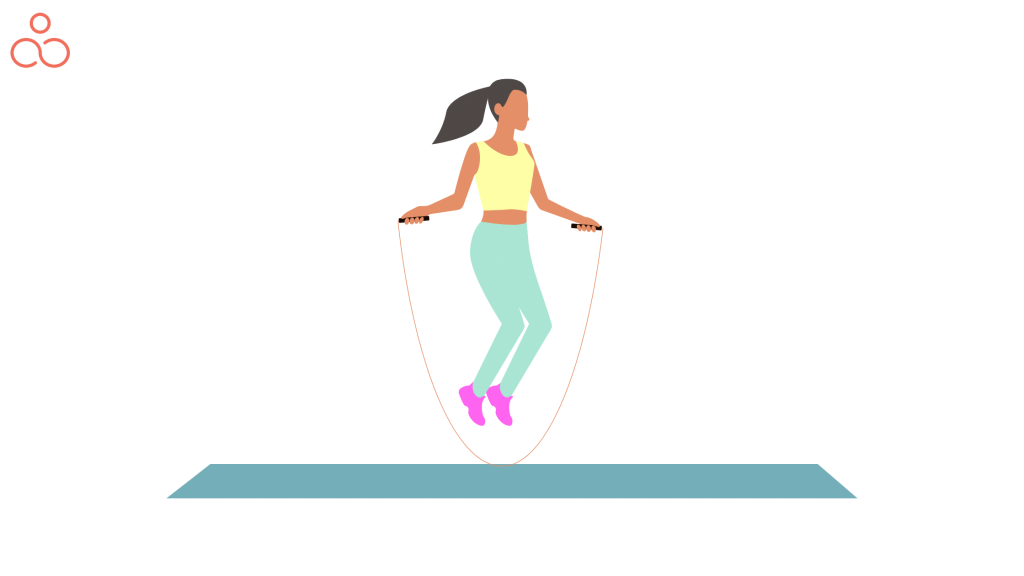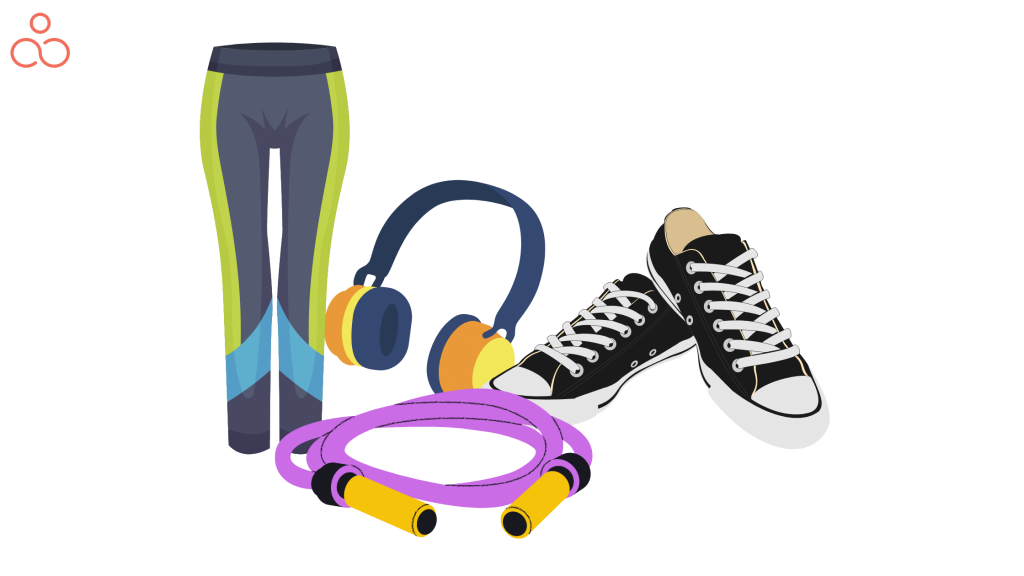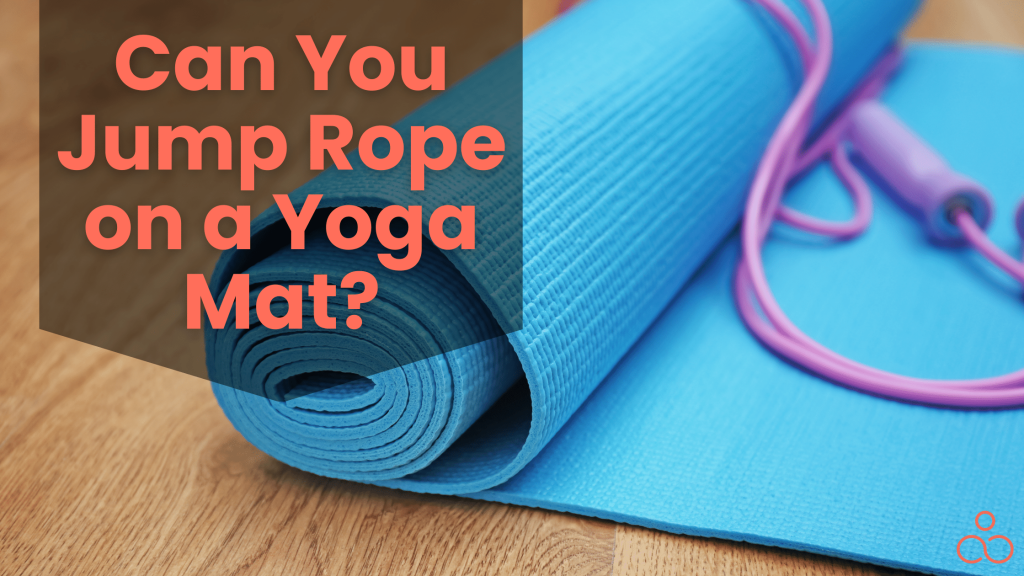Aren’t you curious if you can jump rope on a yoga mat or if it’s too risky? It may sound like a silly question, yet it is vital. Jumping rope is an excellent form of cardiorespiratory exercise, and combining it with yoga can be a great way to energize your heart and work up a sweat. Yoga mats are the perfect surface for jump rope workouts. But let’s explore “If they are any better than jump rope yoga mats”, “Is it safe and worth a shot” or “Will it be better to opt for other alternatives” because ultimately, there is no harm in learning more. Get ready to unearth some great secrets and cram up a few tips and tricks for a significant jump rope workout routine from the comfort of your home.
Can you jump rope on a yoga mat instead of a jump rope mat? Which one is better?

Jumping rope on a yoga mat might not be the most comfortable or efficient way to jump rope, but it is certainly possible.
It is an excellent way to get a full-body exercise that can be done in the comfort of your home and requires minimal equipment. A yoga mat can be an excellent alternative to a jump rope mat and provide all the cushioning and support needed when jumping rope.
It’s important to remember that although a yoga mat may provide enough padding for jumping rope, it might not be as durable as a dedicated jump rope mat. Additionally, the extra thickness of the mat can make it harder to keep your footing while jumping.
But there are also many positives to jumping rope on a yoga mat, such as increased safety, portability, and convenience.
Are yoga mats a suitable surface for jumping rope?

The answer is a resounding yes, and there are several reasons why a yoga mat is suitable for jumping rope.
- Yoga mats are perfect for jump roping since they are designed to provide additional cushioning and shock absorption. This cushioning helps reduce the impact and stress on your joints and muscles, allowing you to jump rope more comfortably and for extended periods.
- Yoga mats are typically made of materials that offer superior grip and friction, which makes it easier to stay on your feet while jumping.
- The best type of mat for this exercise is made of foam or rubber, as these materials offer the most incredible cushioning.
- Ensure your mat is properly cleaned before use, and always jump on a clean, dry surface.
With the proper setup, a yoga mat can be an excellent tool to help improve your jumping experience while staying safe and comfortable.
Is it possible to jump rope without a quality yoga mat?

Jumping rope is surprisingly tricky, and it’s only possible to do it with the right equipment. A yoga mat is essential for jump rope exercises, providing a cushion that keeps your feet comfortable while practicing. During a workout, these mats help protect your feet and ankles from impact and injuries, such as shin splints, calf strain, etc. Furthermore, the mat will safeguard your rope from becoming worn out, so you will only need to change the rope occasionally. So, while you don’t need a mat for jumping, it can be a beneficial addition, primarily if you practice jumping regularly. Additionally, a yoga mat provides stability and grip to the surface, making it easier to execute the complex jumps and footwork required for jump rope exercises.
Get the Best Jump Rope Workout with the Perfect Yoga Mat

Any exercise enthusiast will agree that jumping rope as part of your workout routine is about more than using the top jump rope. The mat is equally as important. Making the correct decision about which exercise mat to choose for jumping rope should guarantee that your exercise routine goes smoothly.
Any exercise enthusiast will agree that jumping rope as part of your workout routine is about more than using the top jump rope. The mat is equally as important.
A regular yoga mat is not suitable for rope jumping. It is crucial to purchase a thick mat to protect your joints and your rope. When buying a jumping rope yoga mat, there are several features you will want to consider. These include mobility, grip, durability, size, length, customer feedback, and mat thickness. These includes:
- The mat’s thickness
You want something with sufficient density to function as a nice cushion and aid in absorbing the force of your leaps. If the mat is too thin, you risk injury, and if it’s too thick, it could be challenging to transport. We suggest a thickness of roughly 1/4 inch.
- Length
The length of your mat must be sufficient to prevent trips and falls from your rope catching on the edges. It should be broad enough to prevent you from feeling as though you are slipping off the mat.
- Grip
A sturdy mat will hold you down when you leap and give grip to your shoes as you “rebound.” When you skip, your mat should never move under you.
- Mobility
You need a mat that is both large enough to accommodate your rope’s whole swing and compact enough to fold up and carry with you. Some mats also include a carrying strap.
- Durability
You want something that can withstand rigorous exercises and is composed of high-quality materials.
- Customer feedback
Today’s global marketplace is impressive since it allows you to read reviews and discover what others say about a product. Select a mat based on the outstanding reviews left by actual customers.
You can jump freely on these mats without fear of tripping over the edges – they are spacious enough. Various types are available, and it’s entirely up to you to make the final selection. Unlock the best jump rope workout regime with the perfect yoga mat – your one-stop solution for a complete workout experience!
Enhance Your Best Workout Routine with These Extra Jumping Accessories

Beyond the basics of a good jumping mat and jump rope, these additional accessories can help you get the most out of your exercise routine. Check out these helpful accessories:
- Invest in Good Shoes
Good shoes are a must when it comes to jumping. The right shoes will help maintain your jumping rhythm and protect your feet while offering shock absorbance. Choose shoes with an airy upper and lightweight cushioning for maximum comfort.
- Wear Breathable and Moisture-Wicking Activewear
Choose your activewear wisely! Look for breathable and moisture-wicking fabrics like polyester, nylon, and spandex so you can jump without feeling restricted. The right activewear will wick away sweat and keep you dry, calm, and comfortable throughout your exercise.
- Weighted Jump Rope Handles
Jumping rope is an effective way to train; if you’re serious about it, investing in weighted handles is the way to go. Many jump ropes come with interchangeable handles, so you can switch to heavier ones if you want to increase resistance. Having extra sets of handles makes swapping them over seamless and effortless. Plus, using weighted handles helps tone your biceps and forearms, as it requires more energy to move and hold them.
- Rock Out with an Energizing Playlist
Music has many physical and psychological benefits and can be especially helpful in exercise. Listening to music during your workouts can help you stay mentally focused and distracted from the burn in your muscles. Plus, music with a strong, steady beat can help you push harder and longer, allowing you to make the best of your workout. So, create a playlist of your favorite tracks and rock out as you jump to the beat.
Frequently Asked Questions (FAQs)
Does jumping rope have benefits?
Jumping rope is an excellent form of exercise and doesn’t require any special equipment. Without a rope, you can still get a great workout by mimicking the same movements without the upper body involvement for the rope rotation.
Jumping rope is an activity that offers many benefits, like enhancing cardiorespiratory fitness, strengthening muscles and bones, and boosting coordination and balance. It works multiple muscle groups, including your calves, quads, glutes, hamstrings, obliques, forearms, biceps, shoulders, back, and chest. Primarily, you’ll feel the burn in your lower body – yet, your upper body plays a pivotal role since you have to power the rope to move. Using a weighty rope or handles can get an even more intense workout in the upper body.
It’s worth keeping in mind that skipping may not benefit everyone, especially those with knee or joint issues. Consult your physician if you need clarification on whether rope jumping is secure. Click here to learn more about the benefits of rope jumping.
What is the ideal size for a jumping rope yoga mat?
The ideal size for a jumping rope yoga mat depends on your individual needs and preferences. Generally, it’s best to look for a long mat to give you plenty of space for your feet and skipping rope. You’ll also want to ensure the mat is thick enough to provide cushioning and support for your feet, ankles, and knees.
A longer mat will be better for jumping rope yoga as it will give you room to move and jump without worrying about running out of space. An empirical approach would be to look for a mat at least 6 feet long and 2.5 feet wide. This will provide plenty of room for your feet and the jump rope.
When it comes to the mat’s thickness, most people prefer something at least 1/4 inch thick so that their feet and joints are appropriately cushioned. This thickness should provide the support you need while jumping.
No matter what kind of yoga you are doing or the size of your mat, make sure you choose one made from high-quality materials that will last for many years. That way, you can get the most out of your practice and enjoy it for a long time! Should you need advice on what size yoga mat I should get, then click here.
Can you substitute a jump rope yoga mat with a regular carpet?
Jumping rope yoga mats are usually made of materials like foam or rubber, specifically designed to absorb the shock of the jumping movements, reducing the risk of injury or strain on your joints. Their non-slip surface helps keep you stable while you are jumping.
On the other hand, carpets are usually made of soft materials like wool or polyester, which are not designed to absorb the impact of jumping. Additionally, carpets can be slippery and cause you to slip and fall while exercising, which can be dangerous.
Hence, replacing a jump rope yoga mat with a regular carpet is not recommended. Jump rope yoga mats are specifically designed to provide a supportive and cushioned surface for jump rope exercises, which is not something that a carpet can offer.
Conclusion
Exercise is about more than just your equipment. Whether a pro or a beginner, taking care of your body and equipment is necessary when working out.
So, now you have some quality ideas about whether you can jump rope on a yoga mat and if it’s worth a shot. A jump rope yoga mat is your perfect partner for an optimized and safe exercise session. It cushions your bones, stabilizes your balance, and provides a safe, non-slip surface. Remember – a good mat will prevent injuries, extend your rope’s life, let you enjoy a jump rope workout anywhere, and get the most out of your workout.

